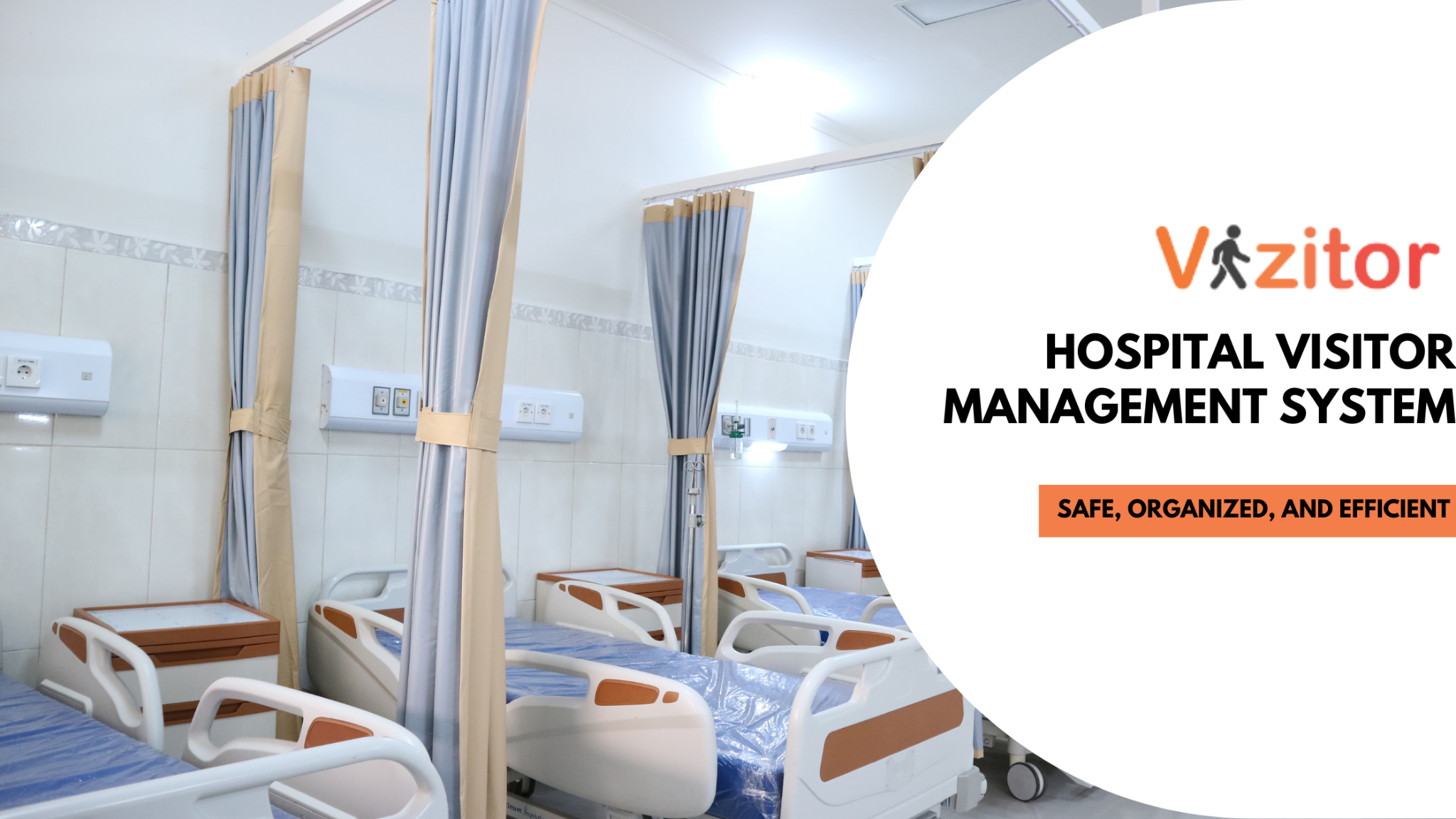Table of Content
Try Vizitor for Free!

Thu, Sep 12, 2024
Read in 13 minutes
Introduction
Did you know that nearly 30% of hospitals report unauthorized access incidents due to inefficient visitor management systems? This alarming statistic highlights a critical issue in healthcare facilities today. Traditional methods of managing hospital visitors often involve lengthy check-in processes, incomplete visitor logs, and inadequate security measures, leading to both inefficiencies and potential security breaches.
Imagine a hospital visit where check-in is as quick and seamless as a hotel check-in, where visitor data is accurately tracked in real-time, and where patient safety is prioritized with state-of-the-art security features. This vision can become a reality with the implementation of advanced visitor management systems (VMS).
Advanced Hospital Visitor Management System have the potential to transform hospital visits by enhancing security, improving operational efficiency, and significantly boosting patient satisfaction. In this blog, we will explore the various ways these systems can revolutionize Hospital Visitor Management Systems, ensuring that every visit is safe, organized, and efficient.
1. The Current State of Hospital Visitor Management
Did you know that nearly 30% of hospitals report unauthorized access incidents due to inefficient visitor management systems? This alarming statistic highlights a critical issue in healthcare facilities today. Traditional methods of managing hospital visitors often involve lengthy check-in processes, incomplete visitor logs, and inadequate security measures, leading to both inefficiencies and potential security breaches.
Imagine a hospital visit where checking in is as quick and seamless as a hotel check-in, where visitor data is accurately tracked in real-time, and where patient safety is prioritized with state-of-the-art security features. This vision can become a reality with the implementation of advanced visitor management systems (VMS).
Advanced VMS have the potential to transform hospital visits by enhancing security, improving operational efficiency, and significantly boosting patient satisfaction. In this blog, we will explore the various ways these systems can revolutionize hospital experiences, ensuring that every visit is safe, organized, and efficient.
A. Inefficiencies in Traditional Systems
One of the most common issues in traditional hospital visitor management systems is the long wait times. Visitors often have to stand in line at reception desks, fill out forms manually, and wait for staff to process their information. This not only wastes time but also creates a frustrating experience for visitors who are already anxious about their loved ones.
Manual check-in processes contribute significantly to these delays. Receptionists must enter visitor details into logbooks or computer systems by hand, which is both time-consuming and prone to errors. In busy hospitals, this process can quickly become overwhelmed, leading to further delays and confusion.
B. Security Concerns
Security is another major concern with traditional visitor management systems. Unauthorized access is a significant risk, as it is difficult to monitor and control who enters and exits the hospital. Without proper checks and balances, anyone can potentially gain access to sensitive areas, putting patients, staff, and visitors at risk.
Inadequate visitor tracking is another critical issue. Many hospitals rely on paper logs or outdated computer systems that do not provide real-time information on who is in the building. This lack of visibility makes it challenging to respond quickly in emergencies, such as evacuations or security incidents. It also complicates the process of ensuring that all visitors have left the premises after visiting hours.
2. The Need for Advanced Visitor Management Systems
A. Enhanced Security
Advanced visitor management systems offer enhanced security features that address the shortcomings of traditional methods. One key feature is real-time tracking of visitors. With advanced VMS, hospitals can monitor who is on the premises at any given time. This helps ensure that only authorized individuals are allowed access to specific areas, reducing the risk of unauthorized entry.
Integration with hospital security systems is another major advantage. Advanced Hospital Visitor Management System can work seamlessly with existing security infrastructure, such as surveillance cameras and access control systems. This creates a comprehensive security network that enhances the safety of patients, staff, and visitors. For instance, the system can alert security personnel immediately if a visitor tries to enter a restricted area.
B. Improved Efficiency
In addition to enhanced security, advanced VMS significantly improve efficiency. One of the most notable improvements is the streamlined check-in and check-out processes. Instead of filling out forms manually, visitors can check in using self-service kiosks or mobile apps. This reduces wait times and minimizes the workload for hospital staff.
Automated data collection and visitor logs are also crucial benefits. Advanced VMS automatically record visitor information, including check-in and check-out times. This data is stored digitally, making it easy to access and analyze. Hospitals can quickly generate reports on visitor activity, helping them make informed decisions about security and operations.
3. Controversial Aspects of Implementing Advanced VMS in Hospitals
A. Privacy Concerns
One of the biggest concerns with implementing advanced visitor management systems in hospitals is privacy. Collecting and storing visitor data digitally raises questions about potential misuse. For instance, if this data falls into the wrong hands, it could be used for identity theft or other malicious purposes.
Balancing security with privacy is a delicate issue. While advanced Visitor Management System for Hospitals can enhance security by keeping detailed records of visitors, it’s essential to ensure that this data is handled responsibly. Hospitals need to implement strict data protection policies to safeguard visitor information. Transparency with visitors about how their data will be used and protected is also crucial to maintaining trust.
B. Cost Implications
Another controversial aspect of advanced VMS is the cost. Implementing these systems requires a significant initial investment in technology and infrastructure. For many hospitals, especially public ones with tight budgets, this can be a major hurdle.
However, it’s important to consider the long-term savings that advanced VMS can offer. By streamlining check-in processes and reducing administrative workload, these systems can save hospitals money over time. Additionally, enhanced security measures can prevent costly security breaches and improve overall operational efficiency.
Balancing the immediate financial outlay with potential long-term benefits is a challenge that hospitals must carefully consider. Exploring funding options, such as grants or partnerships, can help alleviate some of the financial pressure.
4. Benefits of Advanced Visitor Management Systems For Hospitals
Advanced Hospital Visitor Management System bring a range of benefits to hospitals, particularly in enhancing the experiences of hospital employees and improving patient care. Here are ten key advantages of implementing a VMS in a hospital setting:
1. Enhanced Security for Staff and Patients
A VMS ensures that only authorized individuals gain access to specific areas within the hospital. This heightened security helps protect both staff and patients from potential threats, creating a safer environment for everyone.
2. Streamlined Check-in Process
Traditional visitor check-in methods can be time-consuming and inefficient. A VMS simplifies this process, allowing visitors to check in quickly and easily. This reduces wait times and minimizes disruptions for hospital staff, enabling them to focus more on patient care.
3. Accurate Visitor Tracking
A VMS keeps precise records of all visitors, including entry and exit times. This information is crucial for maintaining a secure environment and can be useful in case of emergencies or investigations, providing hospital employees with peace of mind.
4. Improved Patient Privacy
With controlled access to patient areas, a VMS helps protect patient privacy by ensuring that only authorized visitors can enter. This reduces the risk of unauthorized individuals accessing sensitive patient information or disturbing patients during their recovery.
5. Enhanced Efficiency for Hospital Staff
By automating the visitor check-in process, a VMS frees up time for hospital staff, allowing them to focus on their primary responsibilities. This increased efficiency can lead to better patient care and more streamlined hospital operations.
6. Better Communication
A VMS can automatically notify hospital staff when a visitor arrives, improving communication and coordination. This ensures that visitors are promptly attended to and directed to the appropriate areas, reducing confusion and enhancing the overall visitor experience.
7. Emergency Preparedness
In case of an emergency, a Hospital Visitor Management System provides real-time data on the number and location of visitors within the hospital. This information is vital for hospital staff to manage evacuation procedures effectively and ensure everyone’s safety.
8. Compliance with Regulations
Hospitals must adhere to various regulations regarding visitor management and patient privacy. A VMS helps ensure compliance by maintaining accurate records and controlling access to sensitive areas, reducing the risk of regulatory breaches.
9. Improved Visitor Experience
A streamlined and efficient check-in process enhances the overall visitor experience. Visitors appreciate the ease and speed of the process, which reflects positively on the hospital and contributes to a welcoming environment.
10. Resource Allocation
By providing detailed data on visitor patterns and peak times, a VMS helps hospital administrators make informed decisions about resource allocation. This can lead to better staffing decisions, reduced overcrowding, and improved overall hospital efficiency.
5. Future of Visitor Management in Hospitals
The future of hospital visitor management looks promising, with exciting developments on the horizon. One major trend is the integration of Visitor Management Systems (VMS) with other hospital systems. For example, linking a VMS with Electronic Health Records (EHR) and appointment scheduling systems can create a seamless experience. This integration allows hospital staff to manage visitor access based on patient appointments and medical records, improving efficiency and patient care.
A. Integration with Other Hospital Systems
- Electronic Health Records (EHR): Integrating Visitor Management Systems (VMS) with EHR ensures that visitor access is aligned with patient records. This connection helps manage who can visit based on medical appointments and confidentiality requirements.
- Appointment Scheduling Systems: Linking Hospital Visitor Management System with appointment scheduling systems allows for better coordination of visitor check-ins, aligning them with patient appointment times and reducing wait times.
B. Emerging Technologies
- Use of AI and Machine Learning for Predictive Analytics: AI and machine learning can analyze visitor patterns and predict peak times, helping hospitals manage visitor flow more effectively and optimize staff allocation.
- Potential for Biometrics and Facial Recognition: The use of biometrics and facial recognition technology can enhance security and streamline the check-in process. These technologies offer quick and accurate identification, ensuring that only authorized individuals access sensitive areas.
How Will Vizitor Help You?
Vizitor is an advanced Visitor Management System designed to streamline and enhance the visitor experience in hospitals and other institutions. It helps organizations manage and monitor visitors efficiently, ensuring safety, compliance, and a smooth operational flow.
How Vizitor Helps Clients
Vizitor has proven effective for many clients by providing tailored solutions that address their needs. For example:
- Hard Rock Cafe: Vizitor improved guest experience by simplifying check-in processes, enhancing security, and managing high visitor traffic efficiently.
- Snapdeal: Vizitor streamlined visitor management in their offices, facilitating smoother operations and better security protocols.
- Retina Centre: Vizitor helped manage patient and visitor flow, ensuring a safe and organized environment for medical staff and patients.
Top Features of Vizitor for Hospital Management
-
Efficient Check-In and Check-Out:
Vizitor offers self-service kiosks and mobile check-in options. Visitors can quickly check in, receive digital badges, and proceed to their destinations without long wait times.
-
Enhanced Security:
The system tracks visitor movements and provides real-time updates. Hospitals can monitor who is in the building at any moment, improving security and ensuring that unauthorized individuals are not on the premises.
-
Health Compliance:
Vizitor helps hospitals comply with health regulations by verifying visitor health status before allowing entry. This includes checking if visitors have had necessary health screenings or vaccinations.
-
Real-Time Communication:
The system enables instant communication between visitors and hospital staff. Visitors can request assistance or information through the system, and staff can quickly respond, improving overall efficiency.
-
Visitor Analytics:
Vizitor provides detailed reports and analytics on visitor patterns. Hospitals can use this data to optimize visitor management, adjust visiting hours, and improve staff scheduling.
-
Integration Capabilities:
Vizitor integrates seamlessly with other hospital systems, such as electronic health records (EHR) and security management systems, ensuring a cohesive approach to managing hospital operations.
-
Customizable Features:
The system can be customized to meet the specific needs of hospitals, including setting up different visitor types (e.g., patients, family members, contractors) and defining access levels.
Type of Visitor Management System Vizitor Provides
Vizitor offers a comprehensive Hospital Visitor Management System that includes both digital and physical components. It features self-service kiosks for quick check-ins, mobile applications for remote check-ins, and a centralized dashboard for staff to monitor and manage visitor activity. The system is designed to enhance security, streamline operations, and improve the overall visitor experience in hospital environments.
In summary, Vizitor’s top features make it an ideal choice for hospitals seeking to improve visitor management through efficient check-ins, enhanced security, health compliance, real-time communication, and detailed analytics. Its integration capabilities and customizable options ensure it meets the specific needs of healthcare facilities.
Frequently Asked Questions
1. What is a Hospital Visitor Management System?
A Hospital Visitor Management System (VMS) is a digital solution designed to streamline the process of managing visitors in healthcare settings. It includes features for check-in and check-out, visitor tracking, security, compliance with health regulations, and real-time communication between visitors and hospital staff.
2. Why is a Visitor Management System important for hospitals?
A VMS is crucial for hospitals because it enhances security, ensures compliance with health regulations, improves the visitor experience, and streamlines administrative processes. It helps hospitals manage high visitor traffic, prevent unauthorized access, and provide accurate visitor data.
3. How does a VMS improve hospital security?
A Hospital Visitor Management System improves security by monitoring visitor movements, issuing digital badges, and providing real-time updates on who is in the hospital. This helps prevent unauthorized access and ensures that security protocols are followed.
4. Can a Visitor Management System help with health compliance?
Yes, a VMS can assist with health compliance by verifying visitor health status before entry. This may include checking if visitors have undergone necessary health screenings or vaccinations, which is crucial for maintaining patient safety.
5. How does the check-in process work with a VMS?
Visitors can check in using self-service kiosks, mobile applications, or reception staff. They typically enter their details, receive a digital or printed badge, and are directed to their destination within the hospital. The system captures and records visitor information for tracking and security purposes.
6. What are the benefits of real-time communication features in a VMS?
Real-time communication features allow visitors to send requests or messages to hospital staff, who can then respond promptly. This improves efficiency and ensures that visitors’ needs are met quickly, enhancing their overall experience.
7. Can a VMS integrate with other hospital systems?
Yes, many VMS solutions, including Vizitor, offer integration capabilities with other hospital systems such as electronic health records (EHR) and security management systems. This ensures a seamless flow of information and enhances overall operational efficiency.
8. What kind of reports and analytics can a VMS provide?
A VMS provides detailed reports and analytics on visitor patterns, traffic, and behavior. Hospitals can use this data to optimize visitor management, adjust visiting hours, and improve staff scheduling.
9. How does a VMS enhance the visitor experience?
By simplifying the check-in process, providing real-time information and directions, and reducing wait times, a Hospital Visitor Management System enhances the visitor experience. It also offers features like digital badges and notifications, making visits more efficient and pleasant.
10. Is a VMS customizable for different hospital needs?
Yes, many Healthcare Visitor Management System solutions are customizable to meet specific hospital requirements. This includes setting up different visitor types, defining access levels, and tailoring features to align with hospital policies and procedures.









